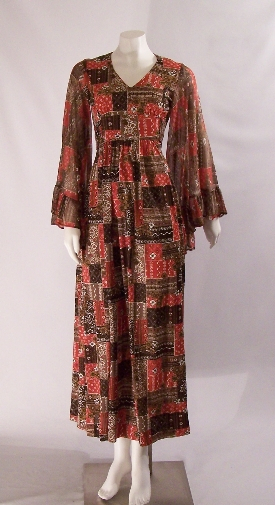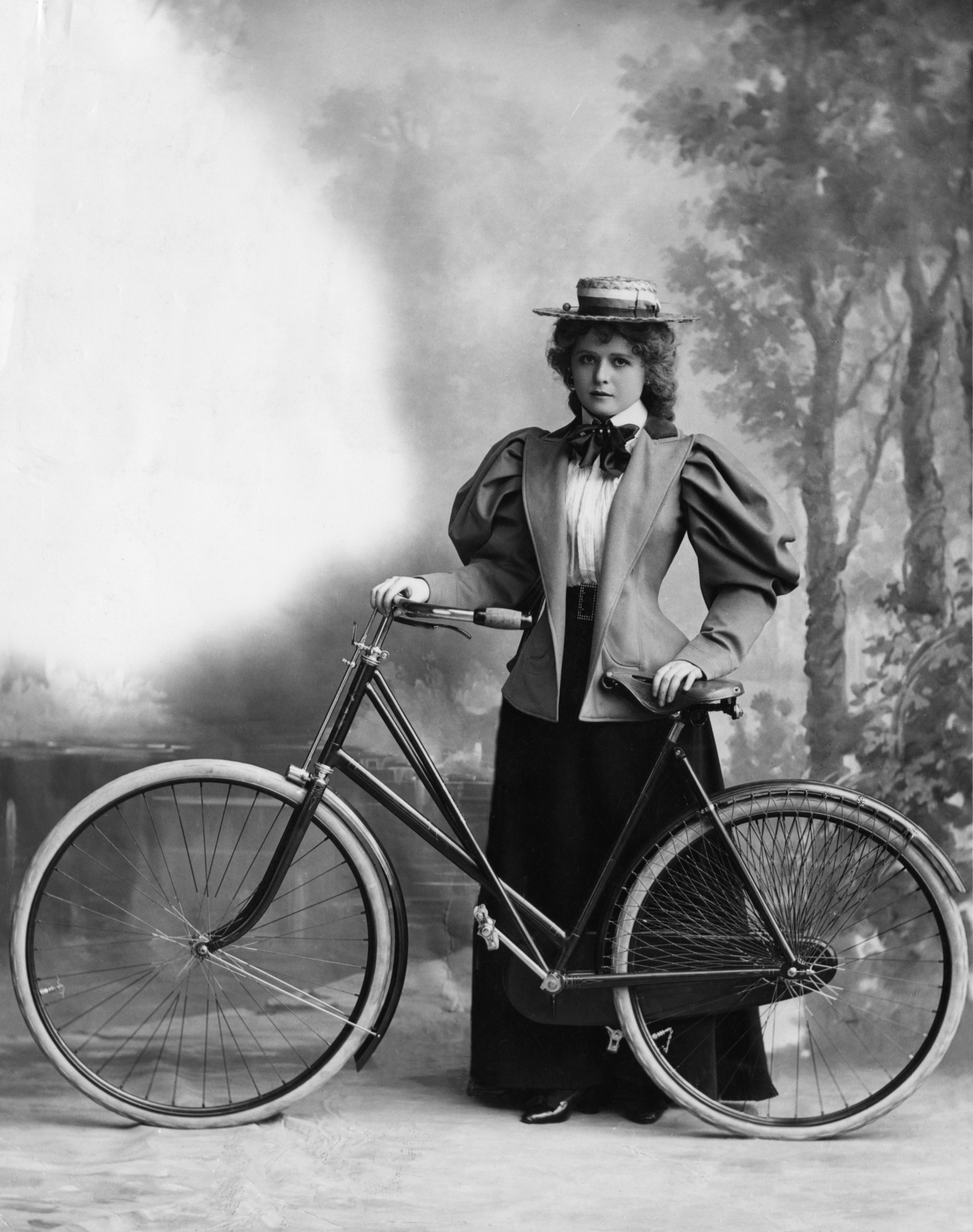|
Bell Sleeve
A bell sleeve can be either long or short and is usually set smoothly into the armscye (no pleating or shirring) and flares toward the bottom. Bell sleeves end anywhere from the elbow to the wrist. Flared sleeves ending at the upper bicep are similarly shaped, but are instead called butterfly sleeves. The effect is reminiscent of a bell in its shape. If the sleeve is relatively full in circumference and is gathered or pleated into both the armhole and at the bottom, it is called a Bishop's Sleeve. History Bell sleeves were originally found on a garment called a chasuble, which was the dress of clergymen during Medieval times. The religious association of these sleeves eventually dissipated at which point the bell sleeve became adapted by the upper class. In the 1500s, the rich began to stylize the bell sleeve by making them more dramatic in size and more elaborate in decor. The trend of this sleeve made its way from the elite of France to England, where this style really too ... [...More Info...] [...Related Items...] OR: [Wikipedia] [Google] [Baidu] |
Maxi Dress
A dress (also known as a frock or a gown) is a garment traditionally worn by women or girls consisting of a skirt with an attached bodice (or a matching bodice giving the effect of a one-piece garment). It consists of a top piece that covers the torso and hangs down over the legs. A dress can be any one-piece garment containing a skirt of any length, and can be formal or casual. A dress can have sleeves, straps, or be held up with elastic around the chest, leaving the shoulders bare. Dresses also vary in color. The hemlines of dresses vary depending on modesty, weather, fashion or the personal taste of the wearer. Overview Dresses are outer garments made up of a bodice and a skirt and can be made in one or more pieces. Dresses are generally suitable for both formal wear and casual wear in the West for women and girls. Historically, dresses could also include other items of clothing such as corsets, kirtles, partlets, petticoats, smocks, and stomachers. History 11th c ... [...More Info...] [...Related Items...] OR: [Wikipedia] [Google] [Baidu] |
Armscye
In sewing, the armscye is the armhole, the fabric edge to which the sleeve is sewn. The length of the armscye is the total length of this edge; the width is the distance across the hole at the widest point. Etymology Multiple theories for the etymology of "armscye" have been proposed. The scholarly etymology has the origin as "arm" + "scye." The first documented use of "scye" in print is by Jamieson (1825) Suppl.: "sey," a Scots and Ulster dialect word (written also scy, sci, si, sie, sy in glossaries) meaning ‘the opening of a gown, etc., into which the sleeve is inserted; the part of the dress between the armpit and the chest (of obscure etymology, and sometimes confused with "scythe" due to similarly curved shapes). A more fanciful folk etymology is as follows. Because the expression "arm's eye" was used in some older sewing texts (e.g. "Gynametry," published in 1887) it is conjectured that in poor prints the apostrophe and the crossbar of the lower case "e" were indisti ... [...More Info...] [...Related Items...] OR: [Wikipedia] [Google] [Baidu] |
Shirring
Shirring is a decorative sewing technique that involves stitching together many rows of gathered fabrics. Shirring reduces the size of the original fabric while adding texture to the resulting decorative fabric. In sewing, shirring is two or more rows of gathers that are used to decorate parts of garments, usually the sleeves, bodice or yoke. The term is also sometimes used to refer to the pleats seen in stage curtains. In the construction of digital 3D clothing shirring can be accomplished by applying a displacement map or normal map when rendering the digital clothing models in a render engine. See also * Gather (sewing) * Godet (sewing) A godet ( or ) is an extra piece of fabric in the shape of a circular sector which is set into a garment, usually a dress or skirt. The addition of a godet causes the article of clothing in question to flare, thus adding width and volume. The most ... * Pleat References Needlework Textile arts {{textile-arts-stub ... [...More Info...] [...Related Items...] OR: [Wikipedia] [Google] [Baidu] |
Butterfly Sleeves
Butterflies are insects in the macrolepidopteran clade Rhopalocera from the order Lepidoptera, which also includes moths. Adult butterflies have large, often brightly coloured wings, and conspicuous, fluttering flight. The group comprises the large superfamily Papilionoidea, which contains at least one former group, the skippers (formerly the superfamily "Hesperioidea"), and the most recent analyses suggest it also contains the moth-butterflies (formerly the superfamily "Hedyloidea"). Butterfly fossils date to the Paleocene, about 56 million years ago. Butterflies have a four-stage life cycle, as like most insects they undergo complete metamorphosis. Winged adults lay eggs on the food plant on which their larvae, known as caterpillars, will feed. The caterpillars grow, sometimes very rapidly, and when fully developed, pupate in a chrysalis. When metamorphosis is complete, the pupal skin splits, the adult insect climbs out, and after its wings have expanded and dried, ... [...More Info...] [...Related Items...] OR: [Wikipedia] [Google] [Baidu] |
Sleeve
A sleeve ( ang, slīef, a word allied to ''slip'', cf. Dutch ) is the part of a garment that covers the arm, or through which the arm passes or slips. The sleeve is a characteristic of fashion seen in almost every country and time period, across a myriad of styles of dress. Styles vary from close-fitting to the arm, to relatively unfitted and wide sleeves, some with extremely wide cuffs. Long, hanging sleeves have been used variously as a type of pocket, from which the phrase "to have up one's sleeve" (to have something concealed ready to produce) comes. There are many other proverbial and metaphorical expressions associated with the sleeve, such as "to wear one's heart upon one's sleeve", and "to laugh in one's sleeve". Early Western medieval sleeves were cut straight, and underarm triangle-shaped gussets were used to provide ease of movement. In the 14th century, the rounded sleeve cap was invented, allowing a more fitted sleeve to be inserted, with ease around the sleeve he ... [...More Info...] [...Related Items...] OR: [Wikipedia] [Google] [Baidu] |
Bell-bottoms
Bell-bottoms (or flares) are a style of trousers that become wider from the knees downward, forming a bell-like shape of the trouser leg. These are similar to flared jeans. History Naval origins In the early 19th century, when a standardized uniform did not yet exist in the U.S. Navy, some sailors adopted a style of wide trousers ending in bell-shaped cuffs. In 1813, one of the first recorded descriptions of sailors' uniforms, written by Commodore Stephen Decatur, noted that the men on the frigates ''United States'' and ''Macedonia'' were wearing "glazed canvas hats with stiff brims, decked with streamers of ribbon, blue jackets buttoned loosely over waistcoats, and blue trousers with bell bottoms." The British Royal Navy had often been a leader in nautical fashion, but bell-bottoms did not become part of the standard uniform until the mid-19th century. These "bell-bottoms" were often just very wide-legged trousers, rather than shaped trousers that flared below the knee. They con ... [...More Info...] [...Related Items...] OR: [Wikipedia] [Google] [Baidu] |


.png)
_male_in_flight.jpg)
